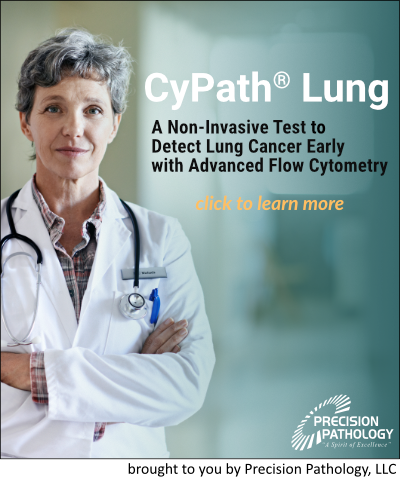“Early Detection of Lung Cancer with Meso Tetra (4-Carboxyphenyl) Porphine (TCPP)-Labeled Sputum”
Journal of Thoracic Oncology, September, 2015
Authors
L. Patriquin, MD, Radiology Assoc.; D. Merrick, MD, Denver VA Medical Center; D. Hill, MD, Waterbury Pulmonary Assoc.; R. Holcomb, PhD, Quintiles; V. Rebel MD, PhD, UTHSCSA; B. Karia, PhD, bioAffinity; G. Bennett, bioAffinity; T. Bauer II, MD, Meridian Health Systems
Abstract
The clinical study demonstrated 81% accuracy in detecting cancer from sputum samples collected from participants in two cohorts. The high-risk cohort included military veterans who had smoked at least 20 pack-years. The cancer cohort included patients diagnosed with lung cancer who provided sputum samples pre-treatment for the disease. A healthy cohort was added and analyzed resulting in 100% sensitivity and specificity. Study design limitations may have lowered accuracy in detecting cancer. For example, only a portion of the sputum sample was evaluated (approximately 30%). Optimization research following this trial supports improved accuracy and methods of automation for commercialization of a non-invasive, early lung cancer test.
Early detection of lung cancer in high-risk individuals reduces mortality. Low-dose spiral computed tomography (LDCT) is the current standard but suffers from an exceedingly high false positive rate (> 96%) leading to unnecessary and potentially dangerous procedures. We therefore set out to develop a simple, noninvasive, and inexpensive quantitative assay to detect lung cancer.
This study evaluated the sensitivity/specificity of the CyPath® Early Lung Cancer Detection Assay to correctly classify LDCT-confirmed cohorts of high-risk control (n=102) and cancer (n=26) subjects. Fluorescence intensity (FI) parameters of red fluorescent cells (RFCs) from TCPP-labeled lung sputum samples and subjects’ baseline characteristics were assessed for their predictive power by multivariable logistic regression. A receiver operating characteristic (ROC) curve was constructed to evaluate the sensitivity/specificity of the CyPath assay.
RFCs were detectable in cancer subjects more often than in high-risk ones (P = 0.015) and their characteristics differed between cohorts. Two independent predictors of cancer were the mean of RFC average FI/area per subject (P < 0.001) and years smoked (P = 0.003). The CyPath-based classifier had an overall accuracy of 81% in the test population; false positive rate of 40% and negative predictive value of 83%.
The TCPP-based CyPath assay correctly classified study participants into cancer or high-risk cohorts with considerable accuracy. Optimizing sputum collection, sample reading, and refining the classifier should improve sensitivity and specificity. The CyPath assay thus has the potential to complement LDCT screening or serve as a stand-alone approach for early lung cancer detection.

